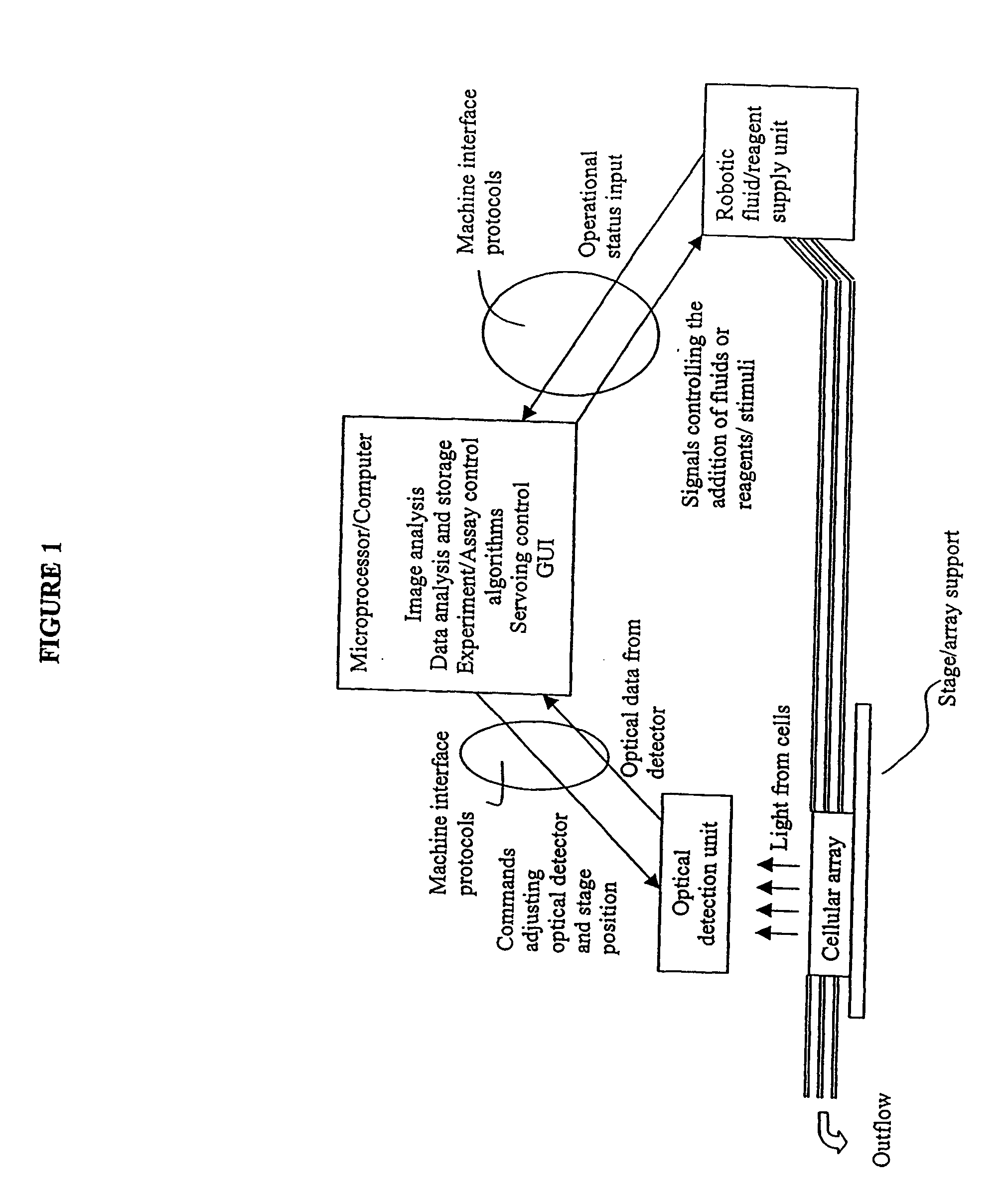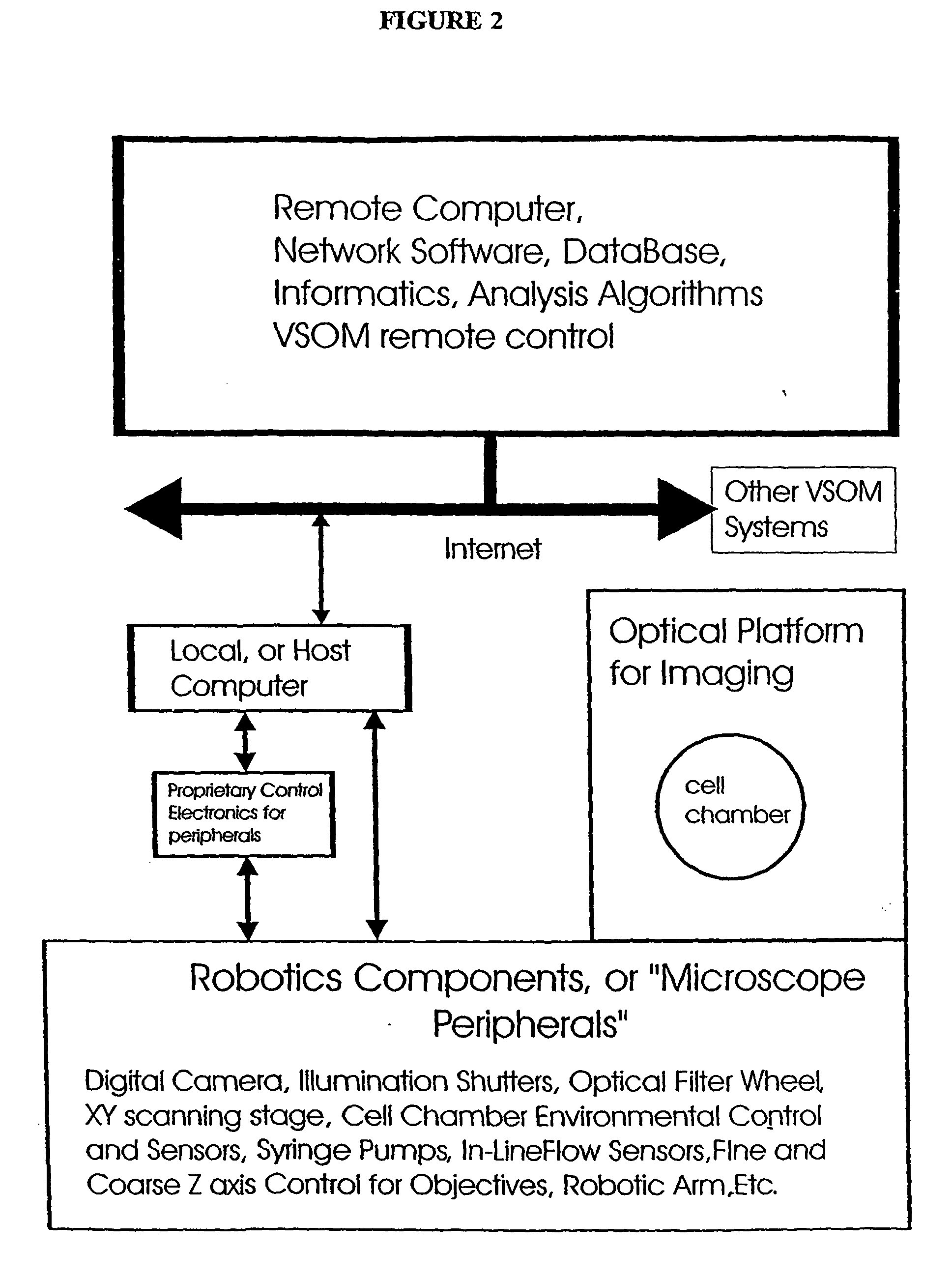Visual-servoing optical microscopy
- Summary
- Abstract
- Description
- Claims
- Application Information
AI Technical Summary
Benefits of technology
Problems solved by technology
Method used
Image
Examples
example 2
[0259] Use of VSOM
[0260] In this Example, the equipment and other aspects of the VSOM of the present invention are described.
[0261] A. VSOM System Optical Platform
[0262] In most embodiments, a VSOM system is built around an inverted (i.e., the objective lens points upwards) fluorescence microscope because cell chambers and cell vessels are typically easier to design when the microscope has this geometry. However, cell chambers do exist that can be used with upright microscopes (where the objective lens points downwards). The VSOM of the present invention is suitable for use with such an optical platform. Biological research grade fluorescence microscopes are preferred, where the microscope has sufficient weight to be stable once the camera and microscope peripherals are mounted on the microscope. A standard 10.times. objective is sufficient for some VSOM experiments. Research grade microscopes, objectives and various peripherals are made by various manufacturers, including Carl Zeis...
example 3
[0279] VSOM Experiment
[0280] In this Example, a VSOM experiment conducted as described in Example 2 is described, with the indicated modifications.
[0281] The optical platform used was a Zeiss Axiovert 135 H / DIC, TV inverted microscope equipped for transmitted light (phase and DIC) and multi-color fluorescence microscopy. It was equipped with a computer-controlled xy scanning stage, z-axis stepping motor, and a six-position filter wheel (LUDL Electronic Products, Ltd. Hawthorne, N.Y.). A 12-bit Xillix CCD camera (Xillix Technologies, Vancouver, BC) containing a Kodak KAF-1400 CCD chip (1317.times.1035 pixels, 7.times.7 micron pixel size) was used for these studies. This camera has a readout rate of 8 MHz (i.e., approximately four full size images per set). Images from the camera were directly read out into the host computer, which was a Sparcstation Ultra 1, a multi-tasking UNIX workstation.
[0282] In addition, a Peltier temperature-controlled microperfusion chamber (PDMI-2 open chamb...
example 4
[0286] MDR Assay--Test Kit and VSOM Experiment
[0287] The MDR Assay .beta.-Test kit was also tested in a VSOM experiment, as described herein. FIG. 11 provides a schematic diagram of this VSOM experiment. Pumps are turned on and off at specified flow rates according to a pre-programmed recipe, or based on real-time analysis of individual cell responses. The CAM, V, and MK concentrations used are noted in the figure. The three exposures to CAM were 900 seconds (20 min) each, and thus the total exposure to CAM was 60 min. The black windows at the bottom of the Figure show the mean response of all cells in the field of view. This mean response plot is displayed on the computer screen during the VSOM experiment, and digital images from one or more channels (transmitted light is usually one of the channels displayed) are displayed on the screen as well.
[0288] The plot and images were continuously refreshed and updated during the experiment. In the two plots recorded for MCF-7 (DS, run #1)...
PUM
 Login to View More
Login to View More Abstract
Description
Claims
Application Information
 Login to View More
Login to View More - R&D
- Intellectual Property
- Life Sciences
- Materials
- Tech Scout
- Unparalleled Data Quality
- Higher Quality Content
- 60% Fewer Hallucinations
Browse by: Latest US Patents, China's latest patents, Technical Efficacy Thesaurus, Application Domain, Technology Topic, Popular Technical Reports.
© 2025 PatSnap. All rights reserved.Legal|Privacy policy|Modern Slavery Act Transparency Statement|Sitemap|About US| Contact US: help@patsnap.com



